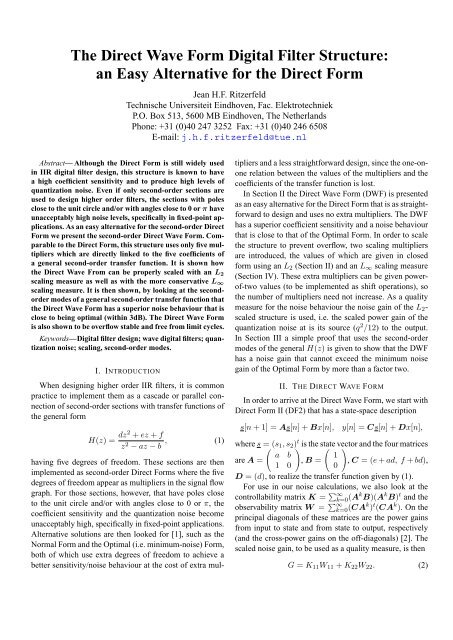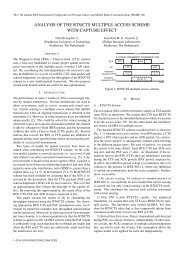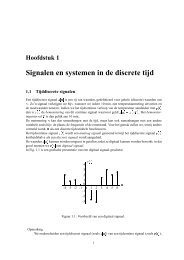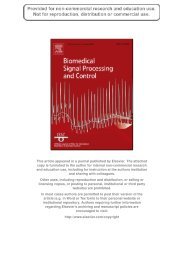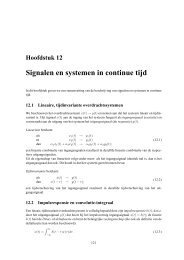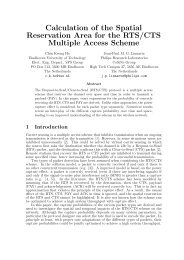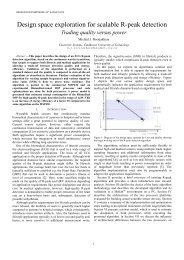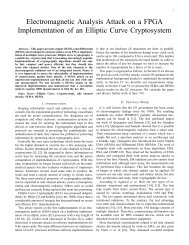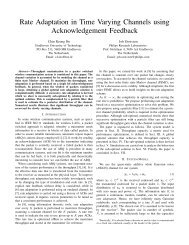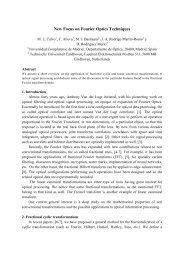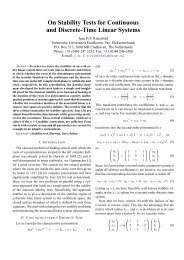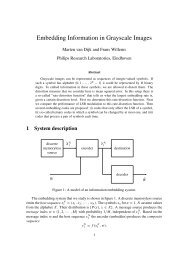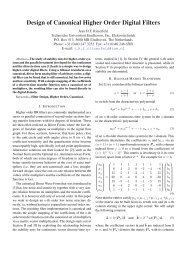The Direct Wave Form Digital Filter Structure - Signal Processing ...
The Direct Wave Form Digital Filter Structure - Signal Processing ...
The Direct Wave Form Digital Filter Structure - Signal Processing ...
Create successful ePaper yourself
Turn your PDF publications into a flip-book with our unique Google optimized e-Paper software.
<strong>The</strong> <strong>Direct</strong> <strong>Wave</strong> <strong>Form</strong> <strong>Digital</strong> <strong>Filter</strong> <strong>Structure</strong>:<br />
an Easy Alternative for the <strong>Direct</strong> <strong>Form</strong><br />
Jean H.F. Ritzerfeld<br />
Technische Universiteit Eindhoven, Fac. Elektrotechniek<br />
P.O. Box 513, 5600 MB Eindhoven, <strong>The</strong> Netherlands<br />
Phone: +31 (0)40 247 3252 Fax: +31 (0)40 246 6508<br />
E-mail: j.h.f.ritzerfeld@tue.nl<br />
Abstract— Although the <strong>Direct</strong> <strong>Form</strong> is still widely used<br />
in IIR digital filter design, this structure is known to have<br />
a high coefficient sensitivity and to produce high levels of<br />
quantization noise. Even if only second-order sections are<br />
used to design higher order filters, the sections with poles<br />
close to the unit circle and/or with angles close to 0 or π have<br />
unacceptably high noise levels, specifically in fixed-point applications.<br />
As an easy alternative for the second-order <strong>Direct</strong><br />
<strong>Form</strong> we present the second-order <strong>Direct</strong> <strong>Wave</strong> <strong>Form</strong>. Comparable<br />
to the <strong>Direct</strong> <strong>Form</strong>, this structure uses only five multipliers<br />
which are directly linked to the five coefficients of<br />
a general second-order transfer function. It is shown how<br />
the <strong>Direct</strong> <strong>Wave</strong> From can be properly scaled with an L 2<br />
scaling measure as well as with the more conservative L ∞<br />
scaling measure. It is then shown, by looking at the secondorder<br />
modes of a general second-order transfer function that<br />
the <strong>Direct</strong> <strong>Wave</strong> <strong>Form</strong> has a superior noise behaviour that is<br />
close to being optimal (within 3dB). <strong>The</strong> <strong>Direct</strong> <strong>Wave</strong> <strong>Form</strong><br />
is also shown to be overflow stable and free from limit cycles.<br />
Keywords—<strong>Digital</strong> filter design; wave digital filters; quantization<br />
noise; scaling, second-order modes.<br />
I. INTRODUCTION<br />
When designing higher order IIR filters, it is common<br />
practice to implement them as a cascade or parallel connection<br />
of second-order sections with transfer functions of<br />
the general form<br />
H(z) = dz2 + ez + f<br />
z 2 − az − b , (1)<br />
having five degrees of freedom. <strong>The</strong>se sections are then<br />
implemented as second-order <strong>Direct</strong> <strong>Form</strong>s where the five<br />
degrees of freedom appear as multipliers in the signal flow<br />
graph. For those sections, however, that have poles close<br />
to the unit circle and/or with angles close to 0 or π, the<br />
coefficient sensitivity and the quantization noise become<br />
unacceptably high, specifically in fixed-point applications.<br />
Alternative solutions are then looked for [1], such as the<br />
Normal <strong>Form</strong> and the Optimal (i.e. minimum-noise) <strong>Form</strong>,<br />
both of which use extra degrees of freedom to achieve a<br />
better sensitivity/noise behaviour at the cost of extra multipliers<br />
and a less straightforward design, since the one-onone<br />
relation between the values of the multipliers and the<br />
coefficients of the transfer function is lost.<br />
In Section II the <strong>Direct</strong> <strong>Wave</strong> <strong>Form</strong> (DWF) is presented<br />
as an easy alternative for the <strong>Direct</strong> <strong>Form</strong> that is as straightforward<br />
to design and uses no extra multipliers. <strong>The</strong> DWF<br />
has a superior coefficient sensitivity and a noise behaviour<br />
that is close to that of the Optimal <strong>Form</strong>. In order to scale<br />
the structure to prevent overflow, two scaling multipliers<br />
are introduced, the values of which are given in closed<br />
form using an L 2 (Section II) and an L ∞ scaling measure<br />
(Section IV). <strong>The</strong>se extra multipliers can be given powerof-two<br />
values (to be implemented as shift operations), so<br />
the number of multipliers need not increase. As a quality<br />
measure for the noise behaviour the noise gain of the L 2 -<br />
scaled structure is used, i.e. the scaled power gain of the<br />
quantization noise at is its source (q 2 /12) to the output.<br />
In Section III a simple proof that uses the second-order<br />
modes of the general H(z) is given to show that the DWF<br />
has a noise gain that cannot exceed the minimum noise<br />
gain of the Optimal <strong>Form</strong> by more than a factor two.<br />
II. THE DIRECT WAVE FORM<br />
In order to arrive at the <strong>Direct</strong> <strong>Wave</strong> <strong>Form</strong>, we start with<br />
<strong>Direct</strong> <strong>Form</strong> II (DF2) that has a state-space description<br />
s[n + 1] = As[n] + Bx[n],<br />
y[n] = Cs[n] + Dx[n],<br />
where s = ((s 1 , s 2 )<br />
t is the state ( vector ) and the four matrices<br />
a b<br />
1<br />
are A = , B = , C = (e + ad, f + bd),<br />
1 0<br />
0<br />
D = (d), to realize the transfer function given by (1).<br />
For use in our noise calculations, we also look at the<br />
controllability matrix K = ∑ ∞<br />
k=0 (A k B)(A k B) t and the<br />
observability matrix W = ∑ ∞<br />
k=0 (CA k ) t (CA k ). On the<br />
principal diagonals of these matrices are the power gains<br />
from input to state and from state to output, respectively<br />
(and the cross-power gains on the off-diagonals) [2]. <strong>The</strong><br />
scaled noise gain, to be used as a quality measure, is then<br />
G = K 11 W 11 + K 22 W 22 . (2)
For DF2, K and W can be given in closed form [1]:<br />
( )<br />
1 − b a<br />
a 1 − b<br />
K =<br />
(3)<br />
(1 + b)(1 − a − b)(1 + a − b)<br />
and W has entries<br />
W 11 = (1 − b)(c2 1 + c2 2 ) + 2ac 1c 2<br />
(1 + b){(1 − b) 2 − a 2 } , W 22 = b 2 W 11 + c 2 2<br />
W 12 = W 21 = ab(c2 1 + c2 2 ) + (1 − a2 − b 2 )c 1 c 2<br />
(1 + b)(1 − a − b)(1 + a − b) , (4)<br />
where c 1 and c 2 are the elements of C = (e+ad, f +bd).<br />
Note, incidentally, that W 11 is just equal to the quadratic<br />
form CKC t , and that W 22 can also be written as W 11 −<br />
{(1 − b)c 1 + ac 2 } 2 /{(1 − b) 2 − a 2 }, so W 22 ≤ W 11 .<br />
<strong>The</strong> <strong>Direct</strong> <strong>Wave</strong> <strong>Form</strong> arises from a state transformation<br />
(a rotation in the state plane) applied to DF2. It has a<br />
recursive part that is remindful of a wave digital filter [3],<br />
hence the designation. <strong>The</strong> state description follows from<br />
the matrices A , B , C , D of DF2 via a similarity transformation<br />
A w = T −1 AT , B w = ( T −1 B, C)<br />
w = CT and<br />
D w = D, where T is taken as 1 1 −1<br />
2<br />
. We find:<br />
1 1<br />
A w =<br />
( ) (<br />
1 − γ1 −γ 2<br />
1<br />
, B<br />
γ 1 −1 + γ w =<br />
2 −1<br />
C w = (η 1 − γ 1 d, η 2 − γ 2 d) and D w = (d), (5)<br />
where γ 1 = 1 2 (1 − a − b), γ 2 = 1 2<br />
(1 + a − b), and where<br />
η 1 = 1 2 (d + e + f), η 2 = 1 2<br />
(d − e + f). Fig. 1 depicts<br />
the <strong>Direct</strong> <strong>Wave</strong> <strong>Form</strong>, which is as yet unscaled and uses<br />
only five multipliers directly related to the five coefficients<br />
of H(z), as does the <strong>Direct</strong> <strong>Form</strong>. Incidentally, apart from<br />
a factor 1 2<br />
, the γ’s are simply found from evaluating the<br />
denominator of H(z) at z = ±1, whereas the η’s are found<br />
from the numerator at z = ±1.<br />
In order to L 2 -scale the DWF, we need to calculate its<br />
controllability matrix, which proves to be diagonal:<br />
( )<br />
4γ2 0<br />
0 4γ<br />
K w = T −1 KT −t 1<br />
=<br />
4γ 1 γ 2 (2 − γ 1 − γ 2 ) , (6)<br />
where the denominator is the same as that of K in (3), as<br />
governed by the stability triangle of a <strong>Direct</strong> <strong>Form</strong> in the<br />
(a, b)-plane: 1+b > 0, 1−a−b > 0, 1+a−b > 0. For the<br />
DWF, the region of linear stability is also a triangle in the<br />
(γ 1 , γ 2 )-plane given by: γ 1 > 0, γ 2 > 0, 2−γ 1 −γ 2 > 0.<br />
In Fig. 2 the L 2 -scaled DWF is drawn, where two extra<br />
multipliers 1/ √ K w11 and 1/ √ K w 22 are introduced.<br />
)<br />
,<br />
✲<br />
✻<br />
z −1 ✛ ❄<br />
s 1 [n] ✛<br />
♥+<br />
❄<br />
❆ ✁<br />
❄<br />
✻ η 1 ❆<br />
✁<br />
❆ ✁<br />
❆✁<br />
❆ ✁ −γ 1<br />
❆✁<br />
x[n] ❄<br />
✲ ♥+<br />
✲ ❍ ❍<br />
❄y[n]<br />
✲ d ❍✟ ✲ ♥+ ✲<br />
✻<br />
✟ ✻<br />
✁❆<br />
✁<br />
✁<br />
❆ −γ 2<br />
❆<br />
✻<br />
z −1 ✛ ✟✟✟ ❍ ✛ + ♥ ❄ η 2<br />
✁ ✁✁❆ ❆<br />
s 2 [n] ✛ −1<br />
❆<br />
❍<br />
✻<br />
❄<br />
✻<br />
✲<br />
✲<br />
Fig. 1. Unscaled <strong>Direct</strong> <strong>Wave</strong> <strong>Form</strong>, where the multipliers are<br />
given by γ 1 = 1 2 (1−a−b), γ 2 = 1 2 (1+a−b), η 1 = 1 2 (d+e+f),<br />
η 2 = 1 2<br />
(d − e + f), realizing the general transfer function (1).<br />
In essence, the scaled DWF of Fig. 2 is the same as the<br />
<strong>Wave</strong> <strong>Digital</strong> <strong>Form</strong> derived in [1]. <strong>The</strong> difference is that in<br />
the DWF the non-state node x[n] − γ 1 s 1 [n] − γ 2 s 2 [n] is<br />
used explicitly to create the output y[n] via the coefficient<br />
d, much in the same way as the non-state node s 1 [n + 1]<br />
in DF2 is connected to the multiplier d to compute y[n]. In<br />
this sense, the DWF is much more analogous to the <strong>Direct</strong><br />
<strong>Form</strong>, hence the designation. Also, the η’s in Figs. 1 and 2<br />
are more directly related to the coefficients of H(z) than<br />
the elements of C w , which would appear as multipliers if<br />
y[n] were computed in the normal ‘state-space’ way with<br />
d directly connecting x[n] and y[n].<br />
✲<br />
✻<br />
z −1 ✛ ❄<br />
s 1 [n] ✛<br />
♥+<br />
❄<br />
√ ❆ ✁<br />
❄<br />
✻ η 1 k11 ❆<br />
✁<br />
❆ ✁ √ ❆✁<br />
❆ ✁ −γ<br />
❆✁<br />
1 k11<br />
✁ ✁✁❆ ❆1/ √ k 11 ❆<br />
x[n] ❄<br />
✻<br />
✲ ♥+<br />
✲ ❍ ❍<br />
❄y[n]<br />
✲ d ❍✟ ✲ ♥+ ✲<br />
✻<br />
✟ ❄<br />
✻<br />
✁❆<br />
√<br />
✁<br />
✁<br />
❆<br />
❆ ✁<br />
−γ 2 k22 ❆<br />
✁ 1/ √ k 22<br />
❆<br />
❆✁<br />
√<br />
✻<br />
z −1 ✛ ✟✟✟ ❍ ✛ + ♥ ❄ η 2 k22<br />
✁ ✁✁❆ ❆<br />
s 2 [n] ✛ −1<br />
❆<br />
❍<br />
✻<br />
❄<br />
✻<br />
✲<br />
✲<br />
Fig. 2. L 2 -scaled <strong>Direct</strong> <strong>Wave</strong> <strong>Form</strong>, where the extra scaling<br />
multipliers are given by 1/ √ K 11 = √ γ 1 (2 − γ 1 − γ 2 ) and<br />
1/ √ K 22 = √ γ 2 (2 − γ 1 − γ 2 ), as determined by K w in (6).<br />
✲<br />
✲
And finally, more so than the <strong>Wave</strong> <strong>Digital</strong> <strong>Form</strong> in [1],<br />
the DWF is a universal ‘biquad’, i.e. an IIR second-order<br />
section to create the standard filter types in a generic way.<br />
For example, taking η 1 = η 2 = 0 creates a bandpass filter<br />
(zeros at ±1), while high- and lowpass filters result from<br />
either η 1 = 0, or η 2 = 0. Next, if we take d = − 1 2<br />
(1+b) in<br />
the bandpass solution and add x[n] to the output, a bandstop<br />
filter is created with transfer function<br />
− 1 2 (1+b) z 2 1<br />
− 1<br />
z 2 − az − b +1 = 2 (1 − b)z2 −az + 1 2<br />
(1 − b)<br />
z 2 ,<br />
− az − b<br />
(7)<br />
which has unity gain at the frequency edges ϑ = 0 and ϑ =<br />
π and a stop frequency ϑ = arccos{a/(1 − b)}. Likewise,<br />
taking d = −(1 + b) and adding x[n] to the output results<br />
in a unity gain allpass filter:<br />
z 2 − 1<br />
−(1 + b)<br />
z 2 − az − b + 1 = −bz2 − az + 1<br />
z 2 − az − b . (8)<br />
So, the filter types bandpass, bandstop and allpass use only<br />
three multipliers in the unscaled structure and five in the<br />
scaled version (since η 1 = η 2 = 0).<br />
III. NOISE GAIN AND SECOND-ORDER MODES<br />
<strong>The</strong> noise gain G w = K w11 W w11 + K w 22 W w 22 of the<br />
DWF can be shown to be near-optimal without actually<br />
calculating it. Due to the fact that K w is diagonal, we<br />
can also write G w = tr(K w W w ), where tr(·) denotes the<br />
trace of a matrix, i.e. the sum of the elements on its principal<br />
diagonal. Since under a state transformation with any<br />
(regular) matrix T the product matrix KW is subject to<br />
a similarity transformation T −1 (KW )T , its eigenvalues<br />
(denoted µ 2 1 and µ2 2 ), trace and determinant are invariant.<br />
<strong>The</strong> square roots µ 1 and µ 2 of these positive, real eigenvalues<br />
are called the second-order modes of H(z), since<br />
they are determined only by the transfer function and do<br />
not change with any specific state-space realization. From<br />
[2] we know that the optimal gain is 1 2 (µ 1 + µ 2 ) 2 , whereas<br />
G w = µ 2 1 + µ2 2 , since the trace of a matrix is the sum of<br />
its eigenvalues. So G w cannot exceed the optimal gain by<br />
more than a factor two, the worst case of 3dB occurring if<br />
µ 1 µ 2 ↓ 0, whereas G w is optimal if µ 1 = µ 2 .<br />
While it is good to know that the DWF is near-optimal,<br />
it is still nice to have explicit expressions for its noise gain,<br />
as well as for the second-order modes. To that end we can<br />
use K and W of DF2 as given by (3) and (4). Starting<br />
with the noise gain, G w is given by<br />
tr(KW )= µ 2 1 + µ 2 g 1 c 2 1<br />
2 =<br />
+ g 2c 2 2 + g 3c 1 c 2<br />
(1 + b) 2 (1 − a − b) 2 (1 + a − b) 2 ,<br />
where<br />
g 1 = (1 + b 2 ){(1 − b) 2 − a 2 } + a 2 (1 + b) 2 ,<br />
g 2 = 2{(1 − b) 2 − a 2 } + a 2 (1 + b) 2 , (9)<br />
g 3 = 2a{(1 − b) 2 − a 2 } + 2a(1 − b)(1 + b) 2 .<br />
Next, knowing the sum of the eigenvalues, we calculate<br />
their product in order to determine µ 1 and µ 2 separately:<br />
det(KW ) = µ 2 1µ 2 (−bc 2 1<br />
2 =<br />
+ c2 2 + ac 1c 2 ) 2<br />
(1 + b) 4 (1 − a − b) 2 (1 + a − b) 2 ,<br />
(10)<br />
where the algebra is not as cumbersome as it might seem,<br />
since det(KW ) = det(K) det(W ) and det(K) from<br />
(3) is simply (1 + b) −2 (1 − a − b) −1 (1 + a − b) −1 . <strong>The</strong><br />
surprisingly nice square numerator of (10) also allows us<br />
to take its square root for a compact expression for µ 1 µ 2 .<br />
<strong>The</strong> optimal gain 1 2 (µ 1+µ 2 ) 2 then is 1 2 G w+µ 1 µ 2 , whereas<br />
1<br />
2 (µ 1 −µ 2 ) 2 is 1 2 G w −µ 1 µ 2 . Combining one with the other<br />
leads to closed-form expressions for µ 1 and µ 2 :<br />
µ 1,2 = 1 2√<br />
Gw + 2µ 1 µ 2 ± 1 2√<br />
Gw − 2µ 1 µ 2 . (11)<br />
To conclude this section, let us look at the case µ 1 = µ 2<br />
more closely, since the DWF is optimal in this case. Developing<br />
µ 1 − µ 2 = √ G w − 2µ 1 µ 2 leads to the strikingly<br />
simple result<br />
µ 1 − µ 2 =<br />
|(1 − b)c 1 + ac 2 |<br />
(1 − a − b)(1 + a − b) , (12)<br />
so µ 1 = µ 2 if (1−b)c 1 +ac 2 =(1−b)e+a(d+f)=0. <strong>The</strong><br />
most useful way to do this, is to take e = 0 and f = −d,<br />
or equivalently, η 1 = η 2 = 0. So, the DWF is optimal in<br />
case of a bandpass, a bandstop, or an allpass filter. Stated<br />
more generally, the DWF is optimal in case of a bandpass<br />
transfer function plus an arbitrary constant, which includes<br />
the bandstop case (d = f = 1 2<br />
(1 − b), e = −a) and the<br />
allpass case (d = −b, e = −a, f = 1). Incidentally, (12)<br />
holds only if −bc 2 1 + c2 2 + ac 1c 2 > 0, which is true for<br />
any practical filter. First of all, for complex poles we have<br />
−b > a 2 /4, so −bc 2 1 + c2 2 + ac 1c 2 is always positive and<br />
secondly, in the real-pole case, the value zero is crossed<br />
only if one of the zeros of H(z) crosses a pole on the real<br />
axis (so µ 1 µ 2 ≠ 0 as long as the system is second-order).<br />
<strong>The</strong> resulting system has alternating real poles and zeros,<br />
and its second-order modes can no longer be equal.<br />
If µ = µ 1 = µ 2 , the product matrix KW is diagonal,<br />
and so KW = µ 2 I, where µ = |d|/(1 + b), since with<br />
e = 0 and f = −d, the matrix W simplifies to<br />
W =<br />
d2<br />
(<br />
1 − b −a<br />
1 + b −a 1 − b<br />
)<br />
(13)
and similarly, W w of the DWF becomes diagonal:<br />
W w = T t W T =<br />
d 2 ( )<br />
γ1 0<br />
. (14)<br />
2 − γ 1 − γ 2 0 γ 2<br />
<strong>The</strong> noise gain is then G w = 2d 2 /(1 + b) 2 . So, if we take<br />
d = 1 2<br />
(1+b) to make a bandpass filter with maximum amplitude<br />
unity at center frequency ϑ = arccos{a/(1 − b)}<br />
(cf. Section II), its noise gain and its second-order modes<br />
are 1 2<br />
. <strong>The</strong> same values hold for the bandstop function (7),<br />
whereas the allpass filter (8) has second-order modes unity<br />
and noise gain 2, since we need to take d = −(1 + b). <strong>The</strong><br />
fact that the noise gain of these filters does not depend on<br />
the pole angles is very remarkable. Even at extreme angles<br />
the noise behaviour of the DWF stays the same, whereas<br />
<strong>Direct</strong> <strong>Form</strong>s become increasingly noisy.<br />
IV. L ∞ -SCALING OF THE DWF<br />
It is important to realize that L 2 -scaling only guarantees<br />
that the state variables in a system have the same variance<br />
as the input signal, so it is a statistical scaling measure: a<br />
low probability of state overflow is ensured only if the input<br />
signal is sufficiently arbitrary (random) and wide-band,<br />
because the variance is determined by the average power<br />
spectrum. If we know the input signal to be narrow-band<br />
or even sinusoidal at varying frequencies (all of course depending<br />
on the specific application), we must normalize<br />
the two frequency responses F 1,2 (e jϑ ) from input to state<br />
to unity at their maximum amplitudes. This is known as<br />
L ∞ -scaling, denoted as ‖F 1,2 ‖ ∞ = max ϑ |F 1,2 (e jϑ )| = 1.<br />
L ∞ -scaling is more conservative than L 2 -scaling, since it<br />
can be shown that ‖F ‖ ∞ ≥ ‖F ‖ 2 . As an example, let us<br />
look at the transfer function F 3 (z) from the input of the<br />
DWF to its non-state node<br />
F 3 (z) = z2 − 1<br />
z 2 − az − b , (15)<br />
which we have already seen to have a maximum amplitude<br />
response of 2/(1 + b). Calculating its L 2 -norm with<br />
∫ π<br />
−π |F 3(e jϑ )| 2 dϑ results in ‖F 3 ‖ 2 = √ 2/(1 + b), so<br />
√ 1<br />
2π<br />
‖F 3 ‖ ∞ = 2<br />
1 + b<br />
√<br />
2<br />
≥ ‖F 3 ‖ 2 =<br />
1 + b . (16)<br />
If we were to scale the non-state node, we would need<br />
to precede it with a multiplier having the inverse values of<br />
(16) for either L ∞ or L 2 -scaling. <strong>The</strong> question of course is:<br />
would it not be prudent (or even necessary) to do so? Although<br />
it is common practice to use extra bits (double precision)<br />
for the summation nodes as compared to the state<br />
variables, it may take quite a few bits to accommodate the<br />
large signals that would result from b close to −1 (i.e. poles<br />
close to the unit circle). So, to answer the question: it all<br />
depends on whether there are enough bits available for the<br />
non-state summation node in a specific design.<br />
Fig. 3 shows the L 2 -scaled DWF with scaling for the<br />
non-state node included. <strong>The</strong> extra scaling multiplier is<br />
denoted 1/ √ K 33 = 1/‖F 3 ‖ 2 = √ (2 − γ 1 − γ 2 )/2, in<br />
imitation of the scaling multipliers for the state variables,<br />
which now appear as √ 2γ 1 = √ K 33 / √ K 11 and √ √<br />
2γ 2 =<br />
K33 / √ K 22 . Even though the number of multipliers has<br />
gone up, Fig. 3 has a certain elegance and may even be<br />
preferred over Fig. 2, because all four multipliers around<br />
the state update now have finite ranges: 0 < √ 2γ 1,2 < 2,<br />
√<br />
0 < γ 1,2 /2 < 1.<br />
✲<br />
✻<br />
z −1 ✛ ❄<br />
s 1 [n] ✛<br />
♥+<br />
❄<br />
√ ❆ ✁<br />
❄<br />
✻ η 1 k11<br />
❆<br />
✁<br />
❆✁<br />
✁ ✁✁❆ ❆✁<br />
✁<br />
❆ x[n] 1/ √ − √ √<br />
γ 1 /2 2γ1<br />
k<br />
❄<br />
✻<br />
✲ ✲ ♥+<br />
✲ ❍ d √ k<br />
❍ 33 33<br />
❄y[n]<br />
❍ ✲ ❍❍ ✲<br />
✟<br />
✟<br />
♥+ ✲<br />
✟<br />
✟<br />
✻<br />
❄<br />
✻<br />
✁❆<br />
✁<br />
❆<br />
✁<br />
− √ √<br />
γ 2 /2 2γ2<br />
❆<br />
❆✁<br />
√<br />
✻<br />
z −1 ✛ ✟✟ ✟<br />
❍❍ ✛ + ♥ ❄ η 2 k22<br />
✁ ✁✁❆ ❆<br />
s 2 [n] ✛ −1<br />
❄<br />
❍<br />
✻<br />
✻<br />
✲<br />
✲<br />
Fig. 3. L 2 -scaled DWF, where the extra scaling multiplier for<br />
the non-state node is given by 1/ √ K 33 = √ (2 − γ 1 − γ 2 )/2.<br />
In much the same way, we can L ∞ -scale the DWF with<br />
or without inclusion of the non-state node. In Fig. 4 the<br />
L ∞ -scaled DWF is drawn, where σ i denotes ‖F i ‖ ∞ , so<br />
σ 3 = 2/(2 − γ 1 − γ 2 ), and where we can choose to forgo<br />
scaling for the non-state node by letting σ 3 = 1. It only<br />
remains to determine σ 1 and σ 2 from<br />
✲<br />
F 1,2 (z) = ±z + 1<br />
z 2 − az − b , (17)<br />
the transfer functions from input to state of the unscaled<br />
DWF. Regrettably, the result is not as simple an expression<br />
as found for σ 3 . Some algebra yields:<br />
1<br />
σ 1 =<br />
(1 − ρ) √ if 2ρ>γ 2 else σ 1 =1/γ 1 ,<br />
2ρ + γ 1 − γ 2<br />
(18)<br />
1<br />
σ 2 =<br />
(1 − ρ) √ if 2ρ>γ 1 else σ 2 =1/γ 2 ,<br />
2ρ − γ 1 + γ 2<br />
where ρ = √ −1 + γ 1 + γ 2 .<br />
(19)
A few remarks on this result are in order: σ 1 and σ 2 are<br />
given in terms of γ 1 and γ 2 , instead of a and b, as are all the<br />
scaling parameters for the DWF (Figs. 2 and 3). Here, this<br />
is particularly useful because the conditions 2ρ > γ 1,2 are<br />
best viewed in the (γ 1 , γ 2 )-plane, where we already have<br />
the stability triangle γ 1 > 0, γ 2 > 0, 2−γ 1 −γ 2 > 0 with<br />
angular points (0, 0), (2, 0) and (0, 2). <strong>The</strong> boundary case<br />
2ρ = γ 2 can also be written as γ 1 = (1 − 1 2 γ 2) 2 , which is<br />
a parabola with tangent lines γ 1 =0 and γ 1 +γ 2 =1 (ρ=0)<br />
touching in (0, 2) and (1, 0), respectively. Likewise, the<br />
boundary 2ρ = γ 1 is the parabola γ 2 = (1 − 1 2 γ 1) 2 , with<br />
tangent lines γ 2 =0 and γ 1 + γ 2 =1 touching in (2, 0) and<br />
(0, 1), respectively. <strong>The</strong>se parabolas mark the transition of<br />
the amplitude responses |F 1,2 (e jϑ )| from having their maximum<br />
at the frequency edges ϑ = 0 or π to some intermediate<br />
frequency. And indeed, as we would expect from the<br />
latter, the region 2ρ > max(γ 1 , γ 2 ), where the left-hand<br />
sides of (18) and (19) hold, is roughly equal to the region<br />
of complex poles (2−γ 1 −γ 2 ) 2 > 4γ 1 γ 2 , or −b > a 2 /4.<br />
Note, that in this region ρ = √ −b is just the pole radius.<br />
✲<br />
✻<br />
z −1 ✛ ❄<br />
s 1 [n] ✛<br />
♥+<br />
❄<br />
❄<br />
✻ η ❆ ✁ 1 σ 1<br />
❆<br />
✁<br />
❆✁<br />
✁ ✁✁❆ ❆✁<br />
✁<br />
−γ 1 σ 1 /σ 3 ❆<br />
σ 3 /σ 1<br />
x[n] ❍ 1/σ 3 ❄<br />
✻<br />
✲ ✲ ♥+<br />
✲ ❍ d σ 3 ❄y[n]<br />
❍ ✲ ❍❍ ✟<br />
✟<br />
✲ ♥+ ✲<br />
✟✟<br />
✻<br />
❄<br />
✟✟<br />
✁❆<br />
❆<br />
✻<br />
✁<br />
−γ 2 σ 2 /σ 3<br />
✁<br />
❆<br />
❆✁<br />
σ 3 /σ 2<br />
✻<br />
z −1 ✛ ✟✟ ✟<br />
❍❍ ✛ + ♥ ❄ η 2 σ 2<br />
✁ ✁✁❆ ❆<br />
s 2 [n] ✛ −1<br />
❄<br />
❍<br />
✻<br />
✻<br />
✲<br />
✲<br />
Fig. 4. L ∞ -scaled <strong>Direct</strong> <strong>Wave</strong> <strong>Form</strong>, where σ 1 and σ 2 are given<br />
by (18) and (19), and where σ 3 is either 2/(2 − γ 1 − γ 2 ) or 1,<br />
depending on whether or not the non-state node need be scaled.<br />
Finally, a note on scaling multipliers. In practice, we do<br />
not need to implement exact values, since scaling is not an<br />
exact science anyway; just choosing between L ∞ and L 2 -<br />
scaling already leads to quite different results. So, we can<br />
round off 1/σ 3 , σ 3 /σ 1 and σ 3 /σ 2 in Fig. 4 to the nearest<br />
powers of two (shift operations). As such, the DWF can be<br />
implemented with just five multipliers. Incidentally, in the<br />
region of complex poles, a good approximation for σ 3 /σ 1<br />
and σ 3 /σ 2 is given by σ 3 /σ 1,2 ≈ √ 2γ 1,2 , holding for ρ →<br />
1. So, the two multipliers leading up to the state nodes have<br />
about the same values as in the L 2 -scaling case of Fig. 3<br />
and will in practice be rounded to the same powers of two.<br />
✲<br />
This then also means that we can use the same central<br />
core of the DWF for both L ∞ and L 2 -scaling by dividing<br />
the three multipliers leading up to the output summation<br />
node by σ 3 and adding an output multiplier σ 3 to compensate.<br />
As a result, the η-multipliers are accompanied by the<br />
same factors σ 1,2 /σ 3 as the γ-multipliers, i.e. power-oftwo<br />
values of 1/ √ 2γ 1,2 , and dσ 3 just becomes d. So, apart<br />
from the input scaling factor (1/σ 3 or 1/ √ K 33 ) and its inverse<br />
at the output, the DWF uses the same five multipliers<br />
(together with two shift operations to scale the state nodes)<br />
for L ∞ and L 2 -scaling. Note that 1/σ 3 is just a shift over<br />
twice the number of bits as 1/ √ K 33 , as determined by the<br />
power-of-two values of (2−γ 1 −γ 2 )/2 and its square root.<br />
An intermediate shift could also be used as middle ground.<br />
V. CONCLUSION<br />
<strong>The</strong> <strong>Direct</strong> <strong>Wave</strong> <strong>Form</strong> is an easy-to-design, virtually<br />
optimal second-order digital filter structure. It combines<br />
the straightforwardness of a <strong>Direct</strong> <strong>Form</strong> in using only five<br />
trivial multipliers, with all the advantages of an optimized<br />
state-space form: it has low coefficient sensitivity and nearminimum<br />
noise, it is overflow stable and free from limit<br />
cycles (cf. Appendix), it is scalable in an easy, calculable<br />
way and it can serve as a universal biquad. So why ever<br />
use a different structure than the <strong>Direct</strong> <strong>Wave</strong> <strong>Form</strong>?<br />
APPENDIX<br />
If the state matrix of a second-order digital filter structure<br />
satisfies the condition [2]<br />
|a 11 − a 22 | ≤ 1 − det(A), (20)<br />
there exists a positive function or norm P (s) of the state<br />
variables, P (s) = |a 21 |s 2 1 +|a 12|s 2 2 , that is non-increasing<br />
with the state transition, or equivalently, P (As) ≤ P (s).<br />
If the system has non-linearities f(s) for quantization, or<br />
F (s) for overflow correction, that are norm-decreasing, the<br />
system will be zero-input stable, i.e. it will reach the zero<br />
state if the input is set to zero, since P =0 for s=0 only.<br />
<strong>The</strong> DWF satisfies (20) with equality, so it is overflow<br />
stable (for any overflow control mechanism) and free from<br />
limit cycles (if truncation is used for the quantizers). <strong>The</strong><br />
fact that (20) is only met with equality means that states on<br />
the line γ 1 s 1 +γ 2 s 2 =0 satisfy P (As) = P (s).<br />
REFERENCES<br />
[1] J.H.F. Ritzerfeld, “Noise gain formulas for low noise second-order<br />
digital filter structures,” Proc. ProRISC 99, Workshop on Circuits,<br />
Systems and <strong>Signal</strong> <strong>Processing</strong>, pp. 383-388, Nov. 1999.<br />
[2] R.A. Roberts and C.T. Mullis, <strong>Digital</strong> <strong>Signal</strong> <strong>Processing</strong>, Addison-<br />
Wesley, 1987, Chapter 9.<br />
[3] A. Fettweis, “<strong>Wave</strong> digital filters: <strong>The</strong>ory and practice,” Proc.<br />
IEEE, vol. 74, pp. 270-327, 1986.


